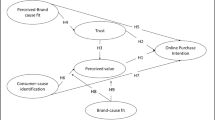Abstract
This research examines how construal level (near/far psychological distance framing) and Perceived Consumer Effectiveness impact response to cause-related marketing appeals (CRM). An on-line experiment was conducted with a North American representative sample of research panel members. Findings demonstrate higher levels of positive affect and purchase intention for psychologically near (vs. far) framing, across all four construal types (temporal, spatial, hypothetical, and social). Dispositional Perceived Consumer Effectiveness increases this preference for proximal framing of CRM appeals, and increases actual charitable behavior as well. A primary contribution of this research is the demonstration that this pattern of preference for proximal framing of CRM appeals holds across all four construal types. Previous research has not examined all four dimensions of psychological distance within a cause-related marketing context. Additionally, the interactive relationship between Perceived Consumer Effectiveness and psychological distance is established for CRM appeals, a relationship that has not previously been identified in this realm. PCE enhances the preference for proximal framing within CRM appeals.



Similar content being viewed by others
References
Bandura, A. (1977). Self-efficacy: toward a unifying theory of behavioral change. Psychological Review, 84, 191–215.
Basil, D. Z., & Herr, P. M. (2006). Attitudinal balance and cause-related marketing: an empirical application of balance theory. Journal of Consumer Psychology, 16(4), 391–403.
Berger, I. E., & Corbin, R. M. (1992). Perceived consumer effectiveness and faith in others as moderators of environmentally responsible behaviors. Journal of Public Policy & Marketing, 11(2), 79–89.
Berglind, M., & Nakata, C. (2005). Cause-related marketing: More buck than bang? Business Horizons, 48, 443–453.
Bigné-Alcañiz, E., Currás-Pérez, R., Ruiz-Mafé, C., & Sanz-Blas, S. (2010). Consumer behavioural intentions in cause-related marketing. the role of identification and social cause involvement. International Review on Public and Nonprofit Marketing, 7(2), 127–143.
Cause Marketing Forum (N.D.) Cause marketing 101 for business, retrieved February 8, 2016, from http://www.causemarketingforum.com/atf/cf/%7B4de6f364-56af-4866-a8d6-be166d012f35%7D/EBOOK_CM101_BUSINESS-2.PDF.
Chandran, S., & Menon, G. (2004). When a day means more than a year: effects of temporal framing on judgments of health risk. Journal of Consumer Research, 31(2), 375–389.
Chang, C. T. (2008). To donate or not to donate? product characteristics and framing effects of cause-related marketing on consumer purchase behaviour. Psychology and Marketing, 25(12), 1089–1110.
Cone Communications/Echo (2013). 2013 Cone communications/Echo Global CSR Study, http://www.conecomm.com/research-blog/2013-cone-communications-echo-global-csr-study. Accessed June 23, 2016.
Cone Communications/Ebiquity (2015). 2015 cone communications/Ebiquity Global CSR Study. http://www.conecomm.com/research-blog/2015-cone-communications-ebiquity-global-csr-study. Accessed June 23, 2016.
Cotte, J., & Trudel, R. (2009). Socially conscious consumerism: A systematic review of the body of knowledge. London: Network for Business Sustainability.
Dodds, W. B., Monroe, K. B., & Grewal, D. (1991). The effects of price, brand, and store information on buyers’ product evaluations. Journal of Marketing Research, 28(3), 307–319.
Ellen, P. S., Wiener, J. L., & Cobb-Walgren, C. (1991). The role of perceived consumer effectiveness in motivating environmentally conscious behaviors. Journal of Public Policy & Marketing, 10(2), 102–117.
Farache, F., Perks, K. J., Wanderley, L. S. O., & de Sousa Filho, J. M. (2008). Cause related marketing: consumers’ perceptions and benefits for profit and non-profits organisations. Brazilian Administration Review, 5(3), 210–224.
Fujita, K., Henderson, M., Eng, J., Trope, Y., & Liberman, N. (2006). Spatial distance and mental construal of social events. Psychological Science, 17(4), 278–282.
Galan-Ladero, M., Galera-Casquet, C., & Wymer, W. (2013). Attitudes towards cause-related marketing: determinants of satisfaction and loyalty. International Review on Public and Nonprofit Marketing, 10(3), 253–269.
Ghosh, S., & Shankar, K. (2013). Red, white, and pink: linking public good contributions to private good sales. Journal of Economic Behavior & Organization, 88, 96–108.
Grau, S., & Folse, J. (2007). Cause-Related Marketing (CRM): the influence of donation proximity and message-framing cues on the less-involved consumer. Journal of Advertising, 36(4), 19–33.
Grolleau, G., Ibanez, L., & Lavoie, N. (2016). Cause-related marketing of products with a negative externality. Journal of Business Research, 69, 4321–4330.
Han, D., Duhachek, A., & Agrawal, N. (2014). Emotions shape decisions through construal level: the case of guilt and shame. Journal of Consumer Research, 41(December), 1047–64.
Keselman, H. J., Rogan, J. C., Mendoza, J. L., & Breen, L. J. (1980). Testing the validity of repeated measures F tests. Psychological Bulletin, 87(3), 479–481.
Kinnear, T. C., Taylor, J. R., & Ahmed, S. A. (1974). Ecologically concerned consumers: who are they? Journal of Marketing, 38(2), 20–24.
Latane, B., & Bourgeois, M. J. (2001). Dynamic social impact and the consolidation, clustering, correlating, and continuing diversity of culture. In M. A. Hogg & R. S. Tindale (Eds.), Blackwell handbook of social psychology: Group processes (pp. 235–258). Oxford: Blackwell.
Lee, J., & Holden, S. S. (1999). Understanding the determinants of environmentally conscious behavior. Psychology & Marketing, 16(5), 373–392.
Lee, H., Deng, X., Unnava, H. R., & Fujita, K. (2014). Monochrome forests and colorful trees: the effect of black-and-white versus color imagery on construal level. Journal of Consumer Research, 41(4), 1015–1032.
Liberman, N., & Trope, Y. (1998). The role of feasibility and desirability considerations in near and distant future decisions: a test of temporal construal theory. Journal of Personality and Social Psychology, 75(1), 5–18.
MacDonnell, R., & White, K. (2015). How construals of money versus time impact charitable giving. Journal of Consumer Research, 42(4), 551–563.
Patel, J. D., Gadhavi, D. D., & Shukla, Y. S. (2016). Consumers’ responses to cause related marketing: moderating influence of cause involvement and skepticism on attitude and purchase intention. International Review on Public and Nonprofit Marketing. doi:10.1007/s12208-016-0151-1.
Ponte, S., & Richey, L. A. (2014). Buying into development? brand Aid forms of cause-related marketing. Third World Quarterly, 35(1), 65–87.
Pracejus, J., Olsen, G., & Brown, N. (2003). On the prevalence and impact of vague quantifiers in the advertising of Cause-Related Marketing (CRM). Journal of Advertising, 32(4), 19–28.
Roberts, J. A. (1996). Green consumers in the 1990s: profile and implications for advertising. Journal of Business Research, 36(3), 217–231.
Runté, M., Basil, D. Z., & Deshpande, S. (2009). Cause-related marketing from the nonprofit’s perspective: classifying goals and experienced outcomes. Journal of Nonprofit and Public Sector Marketing, 21(3), 255–270.
IEG Sponsorship Report (2016). As sponsorship borders fall, spending rises. Retrieved February 8, 2016 from http://www.sponsorship.com/iegsr/2016/01/05/New-Year-To-Be-One-Of-Growth.aspx.
Stuart, E. W., Shimp, T. A., & Engle, R. W. (1987). Classical conditioning of consumer attitudes: four experiments in an advertising context. Journal of Consumer Research, 14(3), 334–349.
Tangari, A. H., Folse, J. A. G., Burton, S., & Kees, J. (2010). The moderating influence of consumer’s temporal orientation on the framing of societal needs and corporate responses in cause-related marketing campaigns. Journal of Advertising, 39(2), 35–50.
Todorov, A., Goren, A., & Trope, Y. (2007). Probability as a psychological distance: construal and preference. Journal of Experimental Social Psychology, 43(3), 473–482.
Trimble, C. S., & Rifon, N. J. (2006). Consumer perceptions of compatibility in cause-related marketing messages. International Journal of Nonprofit and Voluntary Sector Marketing, 11(1), 29–47.
Trope, Y., & Liberman, N. (2003). Temporal construal. Psychological Review, 110(3), 403–422.
Trope, Y., & Liberman, N. (2010). Construal level theory of psychological distance. Psychological Review, 117(2), 440–463.
White, K., MacDonnell, R., & Dahl, D. A. (2011). It’s the mindset that matters: The role of construal level and message framing in influencing consumer efficacy and consumer behaviours. Journal of Marketing Research, 48, 472–485.
Witte, K. (1992). Putting the fear back into fear appeals: the extended parallel process model. Communication Monographs, 59(4), 329–349.
Witte, K., & Allen, M. (2000). A meta-analysis of fear appeals: implications for effective public health campaigns. Health Education & Behavior, 27(5), 591–615.
Wymer, W. W., Jr., & Samu, S. (2003). Dimensions of business and nonprofit collaborative relationships. Journal of Nonprofit & Public Sector Marketing, 11(1), 3–22.
Wymer, W. W., Jr., & Sargeant, A. (2006). Insights from a review of the literature on cause marketing. International Review on Public and Nonprofit Marketing, 3(1), 9–21.
Acknowledgments
This research is the result of the first author’s Master of Science in Management thesis. The authors gratefully acknowledge the financial support received from the University of Lethbridge Master of Science in Management Program to support this research.
Author information
Authors and Affiliations
Corresponding author
Electronic supplementary material
Below is the link to the electronic supplementary material.
ESM 1
(DOCX 405 kb)
Rights and permissions
About this article
Cite this article
Wiebe, J., Basil, D.Z. & Runté, M. Psychological distance and perceived consumer effectiveness in a cause-related marketing context. Int Rev Public Nonprofit Mark 14, 197–215 (2017). https://doi.org/10.1007/s12208-016-0170-y
Received:
Accepted:
Published:
Issue Date:
DOI: https://doi.org/10.1007/s12208-016-0170-y




